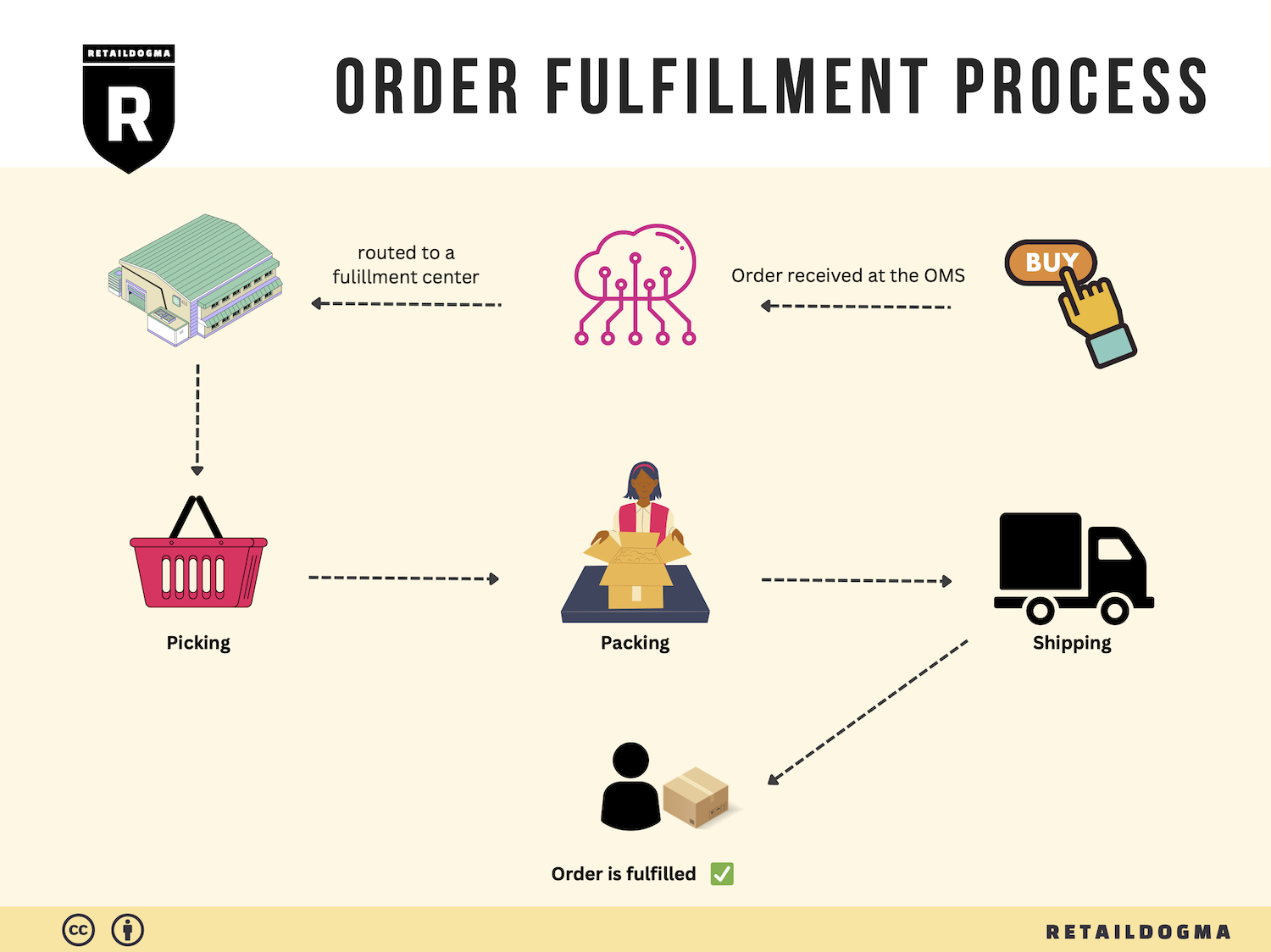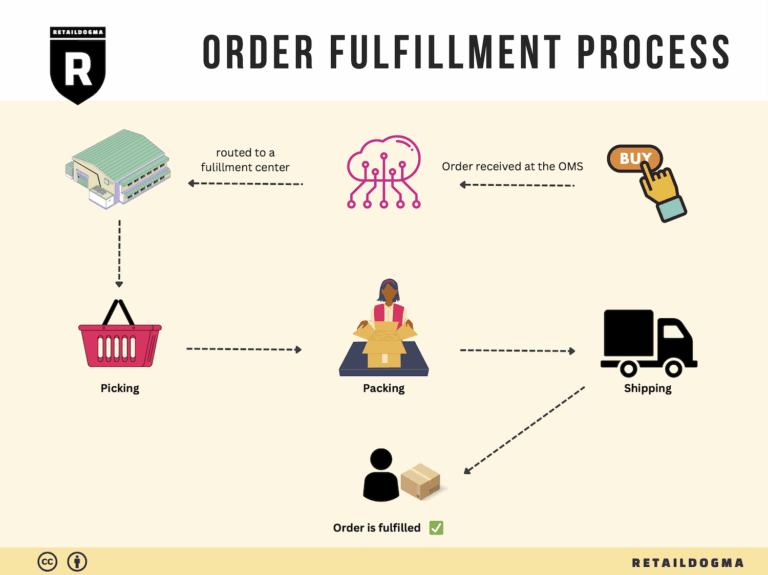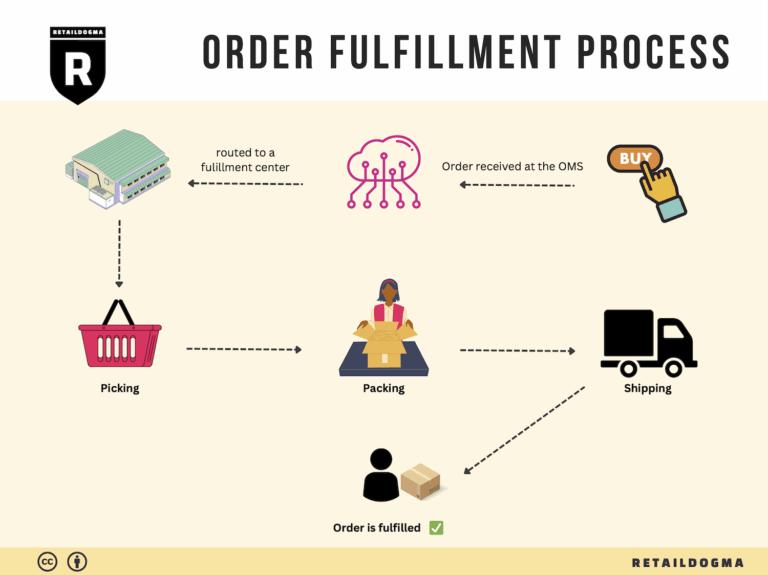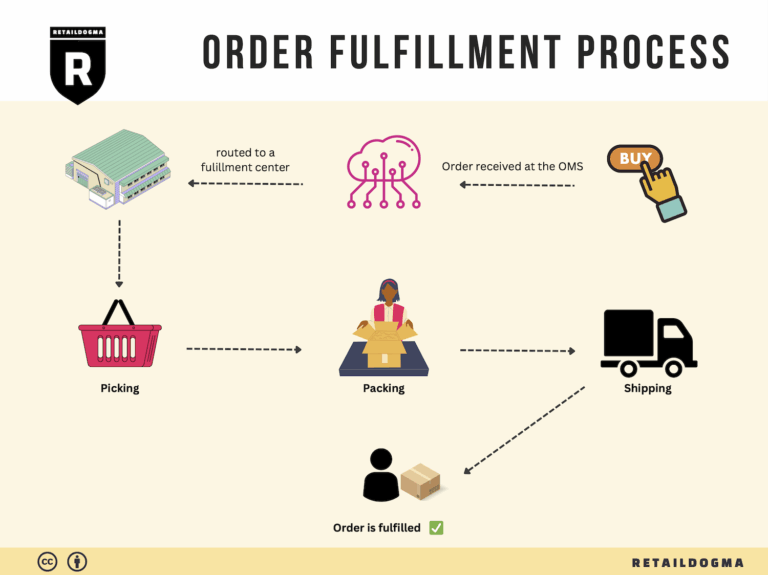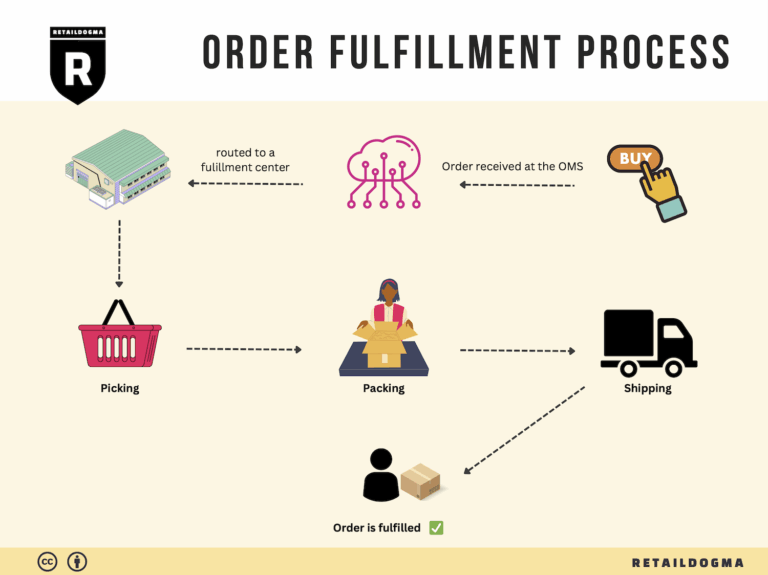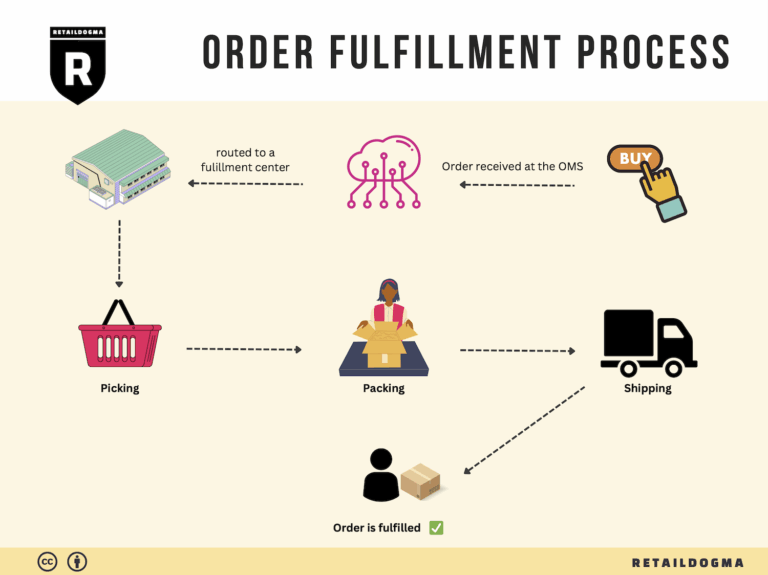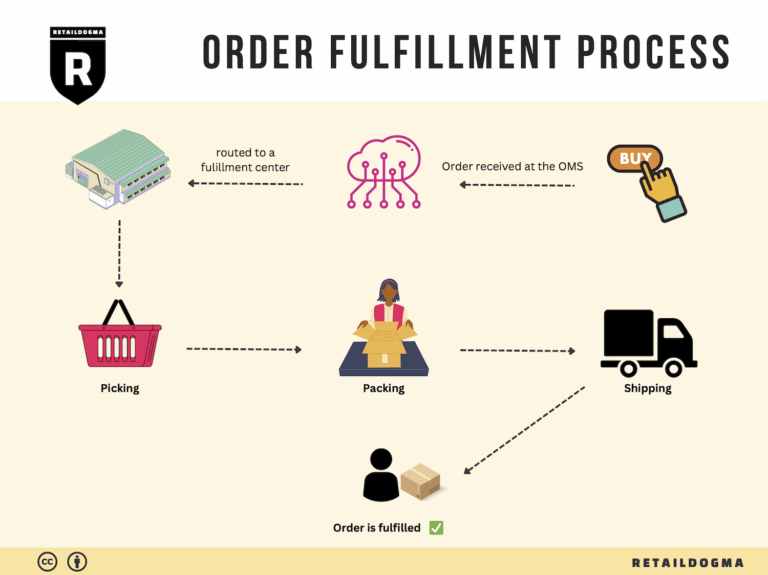What Is A Fulfillment Center? A Complete Guide (2025)
What is E-commerce Fulfillment? An Introduction for Growing Businesses
Understanding E-commerce Fulfillment
As e-commerce businesses grow, many owners find themselves overwhelmed by the logistics of packing and shipping orders. The excitement of increased sales can quickly turn into stress when faced with the complexities of fulfilling customer expectations. Fulfillment, in simple terms, is the process of getting a product from your inventory to your customer’s doorstep. It encompasses everything from inventory management and order processing to shipping and returns.
For many entrepreneurs, navigating this process can be daunting. With numerous fulfillment options available, understanding which model suits your business best is crucial for scaling operations efficiently. This guide will explore various fulfillment models, including third-party logistics (3PL) and Fulfillment by Amazon (FBA), both of which have distinct advantages and considerations.
Key Components of Fulfillment
In addition to outlining different fulfillment models, this guide will delve into the core services involved in e-commerce fulfillment. From warehousing and inventory management to order processing and shipping, each component plays a vital role in ensuring that your customers receive their orders on time and in good condition. We’ll also cover essential aspects such as packaging, tracking, and handling returns, which are critical for maintaining customer satisfaction.
Choosing the Right Fulfillment Partner
Selecting the right fulfillment partner can significantly impact your business’s efficiency and bottom line. This guide will provide practical tips on how to assess potential partners based on their capabilities, technology, and customer service. You’ll learn what questions to ask and what factors to consider when evaluating a fulfillment provider, ensuring you choose a partner that aligns with your business goals.
Understanding Pricing Structures
Pricing is another essential element of e-commerce fulfillment that can affect your overall profitability. We will break down various pricing models, including pay-per-order, flat-rate, and volume-based pricing, helping you understand how to budget for fulfillment costs effectively.
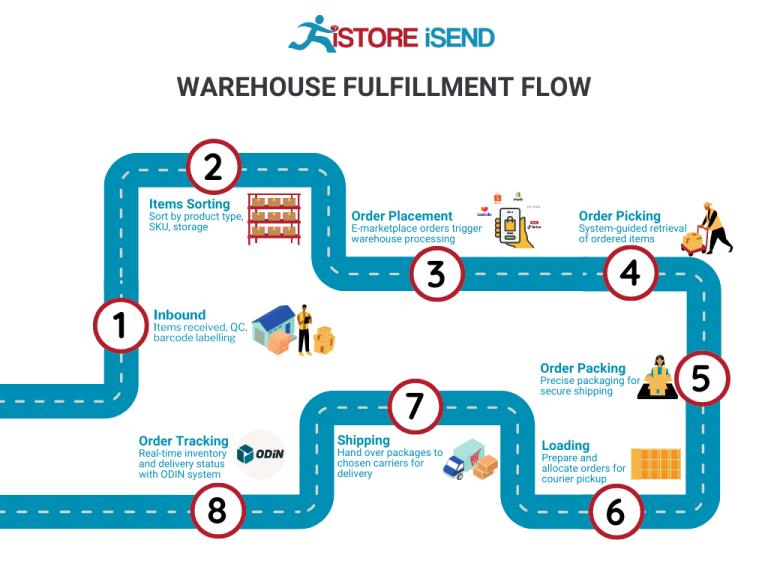
Empowering Smart Logistics Decisions
Ultimately, this guide aims to empower you to make informed decisions about your logistics strategy. By understanding the nuances of e-commerce fulfillment, you will be better equipped to streamline your operations, reduce costs, and enhance customer satisfaction. Whether you’re just starting or looking to scale your business, the insights provided here will help you navigate the complexities of fulfillment with confidence.
What You’ll Learn In This Guide
- What is E-commerce Fulfillment? An Introduction for Growing Businesses
- The Order Fulfillment Process: From ‘Buy’ Button to Customer’s Door
- Comparing Fulfillment Models: In-House vs. 3PL vs. Dropshipping
- A Deep Dive into Amazon FBA: Pros, Cons, and Who It’s For
- Core Services Offered by Fulfillment Centers
- How to Choose a Fulfillment Partner: A 6-Point Checklist
- Understanding Fulfillment Pricing: A Breakdown of Common Fees
- Frequently Asked Questions (FAQs) about Fulfillment
- Conclusion: Is Outsourcing Fulfillment the Right Move for Your Business?
- Important Disclaimer
The Order Fulfillment Process: From ‘Buy’ Button to Customer’s Door
1. Receiving Inventory
The first step in the order fulfillment process begins with receiving inventory at the fulfillment center. This involves the intake of products from suppliers or manufacturers, ensuring that the correct quantities and types of products are delivered. Upon arrival, items are inspected for quality and accuracy against purchase orders. The process includes assigning a Stock Keeping Unit (SKU) to each product, which serves as a unique identifier that helps in tracking inventory throughout the supply chain.
This step is critical because it lays the groundwork for effective inventory management. Accurate receiving ensures that businesses have the necessary stock on hand to meet customer demand, reducing the risk of stockouts and backorders. Efficient inventory management also helps in optimizing warehouse space and minimizing operational costs.
2. Warehouse Storage
Once inventory is received and processed, it is stored in the fulfillment center. Products are organized systematically within the warehouse, often categorized by type, size, or popularity. This organization is facilitated by a Warehouse Management System (WMS), which helps in tracking the location of each SKU in real time.
Proper warehouse storage is essential for maximizing efficiency in the fulfillment process. An organized storage system allows for quick access to products, reducing the time it takes to pick and pack orders. Additionally, well-managed storage helps in preventing damage to products and ensuring that items are stored under optimal conditions. This step can significantly impact the overall speed and accuracy of order fulfillment.
3. Order Picking
When a customer places an order, the next step is order picking. This involves retrieving the ordered items from their storage locations in the warehouse. Fulfillment centers often use pick lists—documents that outline the SKUs and quantities needed for each order—to guide the picking process.
The importance of order picking cannot be overstated; it is a pivotal moment in the fulfillment process where accuracy is paramount. Errors in picking can lead to customer dissatisfaction, returns, and increased operational costs. Many warehouses implement various picking strategies, such as batch picking or zone picking, to enhance efficiency. The use of technology, such as handheld scanners, can further streamline this process by ensuring that the correct items are picked and recorded.
4. Order Packing
After items are picked, they move to the packing stage. This step involves carefully packaging the products to protect them during transit. Proper packing materials, such as boxes, bubble wrap, and packing peanuts, are used to ensure that products arrive at the customer’s door in perfect condition. Each package is labeled with shipping information, including tracking numbers, which enables both the sender and recipient to monitor the shipment’s progress.
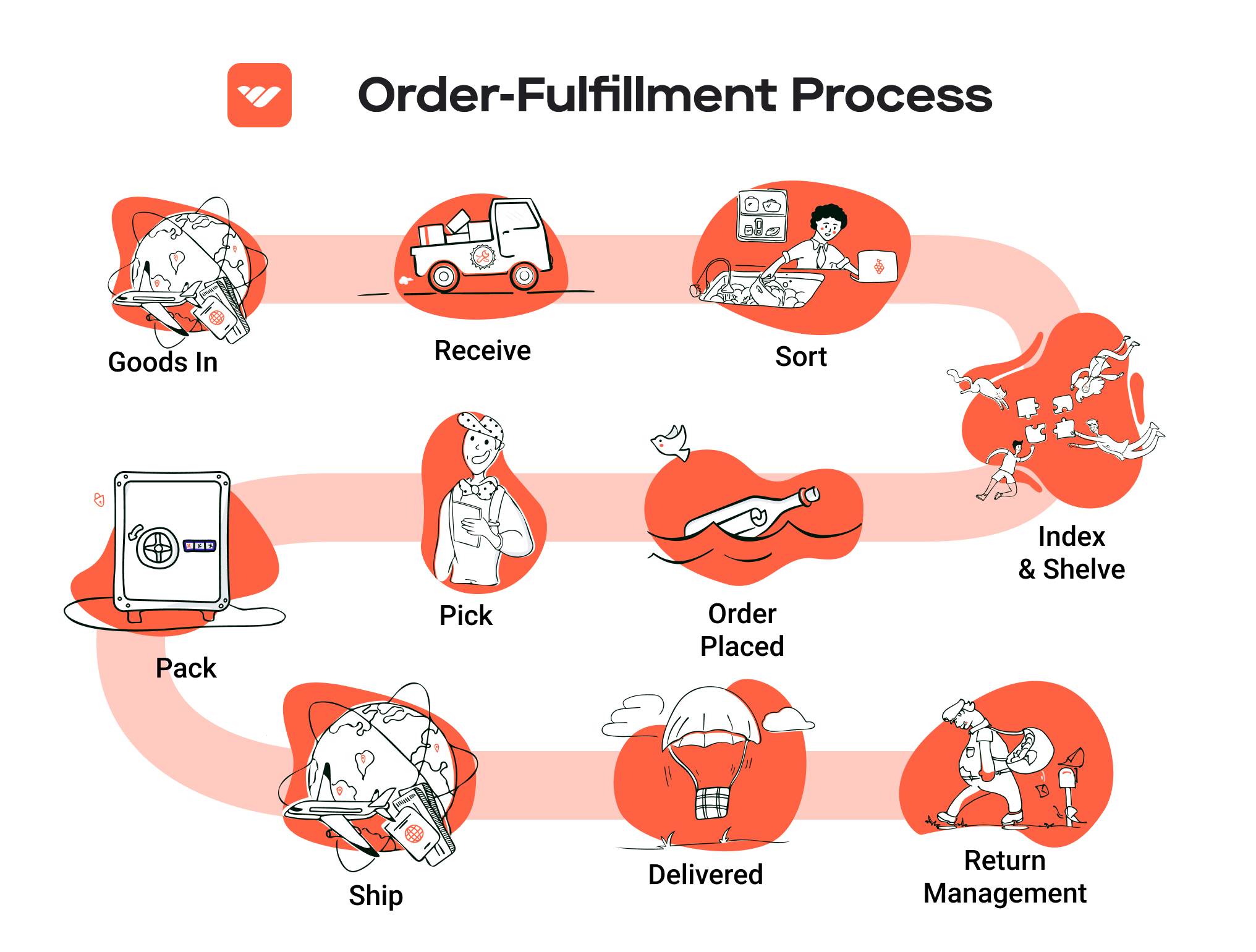
The packing process is crucial for maintaining customer satisfaction. Well-packed items reduce the risk of damage during transportation and enhance the overall unboxing experience for customers. Additionally, efficient packing practices can help control shipping costs by minimizing the size and weight of packages, which directly impacts logistics expenses.
5. Shipping & Delivery
The final step in the order fulfillment process is shipping and delivery. Once packages are packed and labeled, they are dispatched to shipping carriers for delivery to the customer. This step involves selecting the most appropriate carrier based on factors like cost, speed, and service reliability. Tracking systems are employed to monitor the shipment’s journey, providing customers with updates on delivery status.
This stage is vital for fulfilling the promise of fast and reliable delivery, a hallmark of successful e-commerce operations. Timely delivery not only meets customer expectations but also fosters brand loyalty and encourages repeat purchases. Effective shipping strategies, such as offering multiple delivery options and utilizing regional fulfillment centers, can further enhance delivery efficiency and customer satisfaction.
By understanding and optimizing each of these five steps in the order fulfillment process, e-commerce businesses can significantly enhance their operational efficiency, reduce costs, and ultimately improve customer satisfaction.
Comparing Fulfillment Models: In-House vs. 3PL vs. Dropshipping
Fulfillment Models Overview
As e-commerce businesses scale, choosing the right fulfillment model becomes crucial to operational efficiency and customer satisfaction. Below is a comparative analysis of three main fulfillment models: In-House Fulfillment, Third-Party Logistics (3PL), and Dropshipping.
| Model | Who Handles Inventory | Best For (Business Stage) | Key Advantage | Key Disadvantage |
|---|---|---|---|---|
| In-House Fulfillment | The business itself | Established businesses | Greater control over inventory and processes | High operational costs and complexity |
| Third-Party Logistics (3PL) | A third-party provider | Growing businesses seeking scalability | Access to advanced logistics expertise and technology | Less control over fulfillment processes |
| Dropshipping | The supplier | Startups and small businesses | Low upfront costs and no inventory risk | Lower profit margins and potential quality issues |
In-House Fulfillment
In-House Fulfillment involves managing all aspects of inventory storage, order processing, and shipping internally. This model is typically favored by established businesses that have the resources to invest in warehouse space, staffing, and logistics technology.
Advantages: One of the key advantages of in-house fulfillment is the level of control it offers. Businesses can oversee every aspect of their operations, ensuring that products are stored, picked, packed, and shipped according to their specific standards. This control extends to customer service as well, allowing businesses to directly manage their interactions with customers and resolve issues more effectively.
Disadvantages: However, the in-house model comes with significant drawbacks. The initial investment in warehouse space, equipment, and staffing can be substantial. Moreover, as order volume increases, businesses may face challenges related to scalability. Maintaining efficiency in logistics operations requires continuous investment in technology and training, which can strain resources and divert focus from core business activities.
Third-Party Logistics (3PL)
Third-Party Logistics (3PL) involves outsourcing the logistics operations to a specialized provider. This model is ideal for growing businesses that seek to scale their operations without the burden of managing warehousing and distribution themselves.
Advantages: A primary advantage of 3PL is the access it provides to advanced logistics expertise and technology. 3PL providers typically have established networks and systems that can streamline operations, improve shipping speed, and reduce costs. By leveraging these resources, businesses can focus on their core competencies while benefiting from the efficiencies and capabilities of their logistics partner.
Disadvantages: On the downside, using a 3PL provider means relinquishing some control over the fulfillment process. This can lead to challenges in maintaining brand standards, particularly in areas such as packaging and customer service. Additionally, businesses may face difficulties in communication and coordination, which can lead to delays and errors if not managed properly.
Dropshipping
Dropshipping is a fulfillment method where the seller does not keep products in stock. Instead, when a customer makes a purchase, the seller purchases the item from a third party, which then ships it directly to the customer. This model is particularly attractive for startups and small businesses with limited capital.
Advantages: The most significant advantage of dropshipping is the low upfront costs. Businesses do not need to invest in inventory, warehousing, or fulfillment operations, allowing them to enter the market with minimal financial risk. This model also offers flexibility in terms of product offerings, as businesses can easily add or remove items from their catalog without the financial burden of unsold stock.
Disadvantages: However, dropshipping also presents challenges. Profit margins can be lower compared to other fulfillment methods, as suppliers often take a cut of the sales. Moreover, businesses relying on dropshipping may face quality control issues, as they have less oversight over the products being shipped. Shipping times can also be longer, which may impact customer satisfaction and loyalty.
Conclusion
Choosing the right fulfillment model is a critical decision for e-commerce businesses looking to scale. Each model has its own set of advantages and disadvantages, and the best choice will depend on the specific needs, resources, and stage of the business. In-house fulfillment offers control but at a higher cost, 3PL provides scalability with some loss of control, and dropshipping minimizes risk but can impact profit margins and quality. Business owners must carefully evaluate their priorities and capabilities to determine which model aligns best with their growth strategy.
A Deep Dive into Amazon FBA: Pros, Cons, and Who It’s For
Understanding Fulfillment by Amazon (FBA)
Fulfillment by Amazon (FBA) is a service provided by Amazon that allows sellers to store their products in Amazon’s fulfillment centers. Amazon takes care of storage, packaging, and shipping on behalf of sellers. This service is particularly advantageous for e-commerce businesses looking to streamline their operations and expand their reach to millions of customers worldwide.
How FBA Works
When a seller opts for FBA, they send their products to Amazon’s designated fulfillment centers. Once the products are stored in these centers, Amazon handles the entire order fulfillment process. This includes:
- Storage: Products are stored in Amazon’s warehouses until they are sold.
- Order Processing: When a customer places an order, Amazon retrieves the product, packages it, and ships it to the customer.
- Customer Service: Amazon provides customer service for all FBA orders, handling returns and inquiries.
- Shipping: Products fulfilled through FBA are eligible for Amazon Prime, which ensures faster delivery options.
This process allows sellers to leverage Amazon’s vast logistics network, enabling them to reach customers more efficiently and effectively.
Pros of Using FBA
-
Prime Eligibility: One of the most significant advantages of FBA is that products become eligible for Amazon Prime. This exposure can lead to increased sales, as Prime members often prefer to purchase items that offer free two-day shipping.
-
Customer Trust: Customers have a higher level of trust in Amazon’s fulfillment system. When they see that a product is fulfilled by Amazon, it reassures them of the reliability and speed of delivery, which can positively impact conversion rates.
-
Multi-Channel Fulfillment: FBA is not limited to sales on Amazon’s platform. Sellers can use FBA to fulfill orders from their own websites or other marketplaces, making it a versatile option for businesses looking to streamline their logistics across multiple sales channels.
-
Scalability: FBA allows businesses to scale without the need for extensive logistics infrastructure. As sales grow, sellers can easily increase their inventory in Amazon’s fulfillment centers without worrying about storage space or shipping logistics.
-
Time Savings: By outsourcing fulfillment to Amazon, sellers can focus more on other critical aspects of their business, such as marketing, product development, and customer engagement.
Cons of Using FBA
-
High Fees: While FBA provides convenience, it comes at a cost. Sellers incur various fees, including storage fees for inventory and fulfillment fees for each order processed. These costs can add up quickly, particularly for low-margin products.
-
Strict Inventory Rules: Amazon has stringent inventory management rules that sellers must adhere to. This includes limits on the number of units that can be stored, which can be challenging for businesses with seasonal products or fluctuating demand.
-
Commingling Risks: FBA commingles inventory from different sellers, which means that when a product is sold, it may not come from the seller’s specific inventory. This can lead to issues with brand integrity and product quality, as sellers may receive returns of items that do not belong to them.
-
Less Control Over Shipping: When using FBA, sellers have limited control over how their products are packaged and shipped. This can affect brand presentation and customer experience, especially if the packaging does not align with the seller’s branding.
-
Potential for Stockouts: If inventory levels are not managed carefully, sellers can experience stockouts, leading to missed sales opportunities and potential ranking drops in Amazon’s search results.
Who is FBA Best For?
Fulfillment by Amazon is particularly well-suited for:
-
Small to Medium-Sized Businesses: Companies that may not have the resources to manage their own logistics and fulfillment can benefit significantly from FBA’s streamlined processes.
-
Sellers with High Sales Volumes: Businesses that anticipate high sales volumes, particularly in fast-moving consumer goods, can take advantage of FBA to ensure prompt delivery and customer satisfaction.
-
E-commerce Entrepreneurs: New entrepreneurs looking to enter the e-commerce space can leverage FBA to gain instant access to Amazon’s customer base and logistics capabilities without the need for significant upfront investment in infrastructure.
-
Brands Expanding Their Reach: Established brands that wish to reach a broader audience quickly can utilize FBA to enhance visibility and trust among potential customers.
In conclusion, while FBA presents numerous advantages such as Prime eligibility, customer trust, and multi-channel fulfillment, sellers must also weigh the potential downsides, including high fees and strict inventory management rules. Understanding these factors will help businesses make informed decisions about whether FBA is the right fulfillment solution for their needs.
Core Services Offered by Fulfillment Centers
Inventory Management & Warehousing
Inventory management and warehousing are foundational services provided by fulfillment centers. These centers house your products in a controlled environment, utilizing sophisticated inventory management systems to track stock levels, product locations, and order statuses in real time.
What It Is: Fulfillment centers employ advanced software solutions that integrate with your e-commerce platform to provide a seamless view of your inventory. They ensure that products are stored efficiently, organized by category or SKU, and monitored for stock levels to avoid overstocking or stockouts.
Benefits: For e-commerce businesses, effective inventory management minimizes carrying costs and reduces the risk of obsolete inventory. By leveraging the fulfillment center’s expertise, businesses can optimize their stock levels based on demand forecasts and sales trends. This not only enhances operational efficiency but also improves cash flow management, allowing businesses to allocate resources more effectively. Furthermore, centralized warehousing simplifies logistics, making it easier to manage multiple SKUs across various sales channels.
Pick and Pack Services
Pick and pack services are critical to the fulfillment process, enabling the efficient preparation of orders for shipment. This service involves selecting the ordered items from the warehouse shelves, packaging them appropriately, and preparing them for delivery.
What It Is: Once an order is received, fulfillment center staff pick the items from inventory, often using technology like barcode scanners to ensure accuracy. After picking, items are packed securely, often with branded packaging materials, to ensure they arrive safely at the customer’s doorstep.
Benefits: The pick and pack process significantly reduces the time between order placement and shipment, which is vital for maintaining customer satisfaction in the fast-paced e-commerce environment. By outsourcing this function to a fulfillment center, businesses can benefit from their expertise in efficient packing techniques, reducing shipping costs and minimizing product damage. Additionally, accurate picking reduces the likelihood of returns due to incorrect orders, thereby enhancing overall customer experience and loyalty.
Kitting and Assembly
Kitting and assembly services are tailored for businesses that offer products requiring assembly or bundling before they can be sold. This service is particularly beneficial for companies selling complex products or promotional kits.
What It Is: Kitting involves grouping individual items into a single package or kit. This can include everything from assembling furniture pieces to creating gift sets. Fulfillment centers have the manpower and tools to efficiently assemble these products, ensuring quality control throughout the process.
Benefits: By utilizing kitting and assembly services, businesses can streamline their operations and reduce the complexity of their logistics. This service allows companies to offer unique products or bundles that can attract customers and differentiate them from competitors. Moreover, it saves businesses the time and labor costs associated with in-house assembly, allowing them to focus on core activities such as marketing and product development. Additionally, professionally assembled kits can enhance the customer experience, leading to increased satisfaction and repeat purchases.
Returns Management (Reverse Logistics)
Returns management, often referred to as reverse logistics, is a crucial service provided by fulfillment centers that helps businesses efficiently handle product returns from customers.
What It Is: This service encompasses the entire process of returning products, from the initiation of a return request to the inspection, restocking, and eventual resale or disposal of returned items. Fulfillment centers employ streamlined processes to ensure that returns are processed quickly and efficiently.
Benefits: Efficient returns management is vital for maintaining customer trust and satisfaction. When customers know they can return products easily, they are more likely to complete a purchase. Fulfillment centers can also analyze return data to identify trends and issues, helping businesses improve product offerings and reduce future returns. Furthermore, effective reverse logistics can minimize losses associated with returned items by quickly restocking sellable products or providing insights into product quality and customer preferences. By outsourcing this function, e-commerce businesses can enhance their operational efficiency and focus on growth strategies.
In summary, partnering with a fulfillment center offers e-commerce businesses a comprehensive suite of services designed to streamline operations, enhance customer satisfaction, and support scalable growth. By leveraging these core services—inventory management, pick and pack, kitting and assembly, and returns management—businesses can optimize their logistics and focus on their core competencies, ultimately driving sales and profitability.
How to Choose a Fulfillment Partner: A 6-Point Checklist
Location & Warehouse Network
Importance:
The geographical location of your fulfillment partner’s warehouses can significantly impact shipping times and costs. A partner with a well-distributed network can help you reach customers quickly and efficiently.
Questions to Ask:
– Where are your warehouses located, and how does that align with our target market?
– How many fulfillment centers do you operate, and do they cover key shipping zones?
– Can you provide data on shipping times and costs for different regions?
Technology & Integrations
Importance:
In today’s digital landscape, seamless technology integration is crucial. A fulfillment partner should be able to connect with your existing e-commerce platforms, inventory management systems, and customer relationship management (CRM) tools.
Questions to Ask:
– What technology platforms do you use for order management and tracking?
– Can your system integrate with our e-commerce platform? What APIs are available?
– How do you handle inventory management, and can we access real-time inventory data?
Specializations (e.g., cold storage, oversized items)
Importance:
Not all fulfillment centers are equipped to handle every type of product. If your business deals with specialized items—like perishable goods or oversized items—ensure your partner has the necessary facilities and expertise.
Questions to Ask:
– Do you have specialized facilities for specific product types, such as cold storage or hazardous materials?
– What is your experience with handling and shipping the type of products we offer?
– Can you provide case studies or references from similar businesses you have worked with?
Scalability & Capacity
Importance:
As your business grows, your fulfillment needs will evolve. It’s essential to choose a partner that can scale with you, whether that means increasing warehouse space, workforce, or technology resources.
Questions to Ask:
– How do you accommodate seasonal fluctuations in order volume?
– What is your capacity for handling our projected growth over the next 1-3 years?
– Can you provide examples of how you have supported other clients during periods of rapid growth?
Pricing and Contracts
Importance:
Understanding the pricing structure and contract terms is vital to avoid unexpected costs and to ensure a mutually beneficial partnership. Transparent pricing can help you manage your budget more effectively.
Questions to Ask:
– What is your pricing model? Are costs based on volume, weight, or a flat fee?
– Are there any additional fees we should be aware of (e.g., storage, pick-and-pack, shipping)?
– What are the terms of your contract, and is there flexibility in terms of service level agreements (SLAs)?
Customer Support & Reviews
Importance:
Effective communication and support are key to a successful partnership. A partner with strong customer service can help you resolve issues quickly and maintain a positive customer experience.
Questions to Ask:
– What customer support options do you offer (e.g., phone, email, live chat)?
– How do you handle issues or disputes that arise during the fulfillment process?
– Can you provide references or reviews from current clients regarding your customer support?
Conclusion
Choosing the right fulfillment partner is a critical step in scaling your e-commerce business. By using this checklist, you can evaluate potential partners based on essential factors such as location, technology, specializations, scalability, pricing, and customer support. Taking the time to ask the right questions will help ensure that you select a partner who can meet your operational needs and support your growth ambitions effectively.
Understanding Fulfillment Pricing: A Breakdown of Common Fees
Initial Setup Fees
Initial setup fees are often the first costs e-commerce businesses encounter when utilizing fulfillment services. These fees cover the administrative and operational groundwork necessary to onboard a new seller into the fulfillment system. They can include costs associated with account creation, integration with existing e-commerce platforms, and any necessary training sessions for staff.
Calculation: These fees can vary significantly based on the fulfillment provider and the complexity of your operations. Generally, they are a one-time charge, often ranging from a few hundred to several thousand dollars, depending on the scale of your business and the services you require. It’s advisable to request a detailed breakdown to understand what each component of the fee encompasses.
Receiving Fees
Receiving fees are charged when your inventory arrives at the fulfillment center. This fee covers the labor and resources needed to unload, inspect, and store the products in the warehouse. It can also include costs for labeling or repackaging items as required.
Calculation: These fees are typically calculated per unit or per pallet received. The cost can range from $0.20 to $0.50 per item, or $10 to $30 per pallet, depending on the size and weight of the items. It’s crucial to understand these fees, especially if you plan on sending large shipments, as they can quickly add up.
Storage Fees (per pallet/bin)
Storage fees are charged for keeping your inventory in the fulfillment center. This fee is critical for businesses to consider, especially those with fluctuating inventory levels. Storage fees can vary based on the type of storage (i.e., ambient, refrigerated, etc.) and the duration for which the items are stored.
Calculation: Storage fees are usually calculated on a monthly basis and can be charged per pallet, bin, or cubic foot. For example, charges might be $20 to $40 per pallet per month. Some providers may offer tiered pricing based on the volume of goods stored, with lower rates for higher quantities. Understanding your inventory turnover rate can help you anticipate these costs better.
Pick & Pack Fees (per item/order)
Pick and pack fees are incurred when the fulfillment center selects items from inventory and prepares them for shipment. This service is essential for ensuring that the correct items are packaged and sent to customers.
Calculation: Pick and pack fees are often charged per item or per order. A typical fee structure might be $1 to $3 per item for picking and packing, with a flat fee for orders that contain multiple items. It’s wise to clarify whether the fee is charged per item in the order or for the entire order, as this can significantly affect your overall costs, especially for multi-item shipments.
Shipping Fees
Shipping fees are the costs associated with transporting the packaged orders to the customers. These fees can vary based on the destination, shipping method, and the size and weight of the packages.
Calculation: Shipping fees are generally calculated based on the carrier rates, which can fluctuate based on factors like distance, package dimensions, and delivery speed (standard, expedited, etc.). Businesses should also consider additional surcharges for residential deliveries or remote areas. Negotiating rates with carriers or utilizing volume discounts can be advantageous for reducing these costs.
Tips for Getting an Accurate Quote
-
Provide Detailed Information: When requesting quotes from fulfillment centers, provide as much detail as possible about your products, expected order volumes, and shipping preferences. This information enables providers to give more precise estimates.
-
Understand the Fee Structure: Ask for a detailed breakdown of all potential fees, including any hidden costs. This will help you avoid surprises down the line.
-
Compare Multiple Providers: Don’t settle for the first quote you receive. Compare pricing structures from several fulfillment centers to find the best value.
-
Negotiate Terms: Many fulfillment centers are open to negotiation, especially for long-term contracts or higher volumes. Discussing your business’s growth potential may lead to better rates.
-
Consider Additional Services: If you require specialized services (like kitting, custom packaging, or returns handling), ensure these are included in your quote to avoid unexpected charges.
By understanding the various fulfillment pricing models and actively engaging with providers, you can make informed decisions that align with your business needs and budget constraints.
Frequently Asked Questions (FAQs) about Fulfillment
1. What is the Amazon Fulfillment Center HAL1?
The Amazon Fulfillment Center HAL1, located in Albany, NY, is a large-scale facility that specializes in the storage, packing, and shipping of a diverse range of products for Amazon. This center is integral to Amazon’s logistics network, ensuring efficient order processing and timely delivery to customers in the region.
2. How does Amazon Fulfillment work?
Amazon Fulfillment centers receive products from sellers, store them in a warehouse, and manage the entire logistics process. When a customer places an order, the fulfillment center picks, packs, and ships the product directly to the customer, leveraging advanced technology and a dedicated workforce to streamline operations.
3. What’s the difference between a warehouse and a fulfillment center?
A warehouse primarily serves as a storage facility for goods, focusing on inventory management and bulk storage. In contrast, a fulfillment center is designed for the complete order fulfillment process, including picking, packing, shipping, and often handling returns. Fulfillment centers are more focused on customer service and rapid delivery.
4. What is a Third-Party Logistics (3PL) provider?
A Third-Party Logistics (3PL) provider is a company that offers logistics services to businesses, allowing them to outsource their supply chain management. This can include warehousing, order fulfillment, transportation, and more. Using a 3PL can help businesses scale their operations without the burden of managing logistics in-house.
5. How much do fulfillment services cost?
The cost of fulfillment services can vary widely based on factors such as order volume, storage space, shipping methods, and additional services like packaging or returns management. Typically, fulfillment centers charge a combination of storage fees, picking and packing fees, and shipping costs. It’s essential for businesses to evaluate their specific needs to get an accurate estimate.
6. What technology does Amazon use in its fulfillment centers?
Amazon employs advanced technology, including robotics, artificial intelligence, and automated systems, to enhance efficiency in its fulfillment centers. This technology aids in inventory management, order processing, and shipping, allowing for quicker turnaround times and improved accuracy in fulfilling customer orders.
7. How can I partner with Amazon Fulfillment Center HAL1?
To partner with Amazon Fulfillment Center HAL1, businesses can enroll in programs like Fulfillment by Amazon (FBA). This allows sellers to store their products in Amazon’s warehouses, from where Amazon handles storage, packaging, and shipping. Interested businesses should review the requirements and guidelines provided on Amazon’s seller platform.
8. What are the benefits of using Amazon Fulfillment Services?
Utilizing Amazon Fulfillment Services provides several advantages, including access to Amazon’s vast logistics network, faster shipping times, and improved customer satisfaction. Additionally, sellers can benefit from Amazon’s customer service and return management, freeing them to focus on other aspects of their business.
9. How does Amazon ensure order accuracy in fulfillment?
Amazon employs a combination of technology and quality control processes to ensure order accuracy. This includes barcode scanning systems, automated sorting, and rigorous training for fulfillment associates. Regular audits and performance metrics also help maintain high standards in order fulfillment.
10. What should I consider when choosing a fulfillment partner?
When selecting a fulfillment partner, consider factors such as their location relative to your customer base, technology capabilities, pricing structure, scalability, and customer service reputation. It’s crucial to assess how well the partner can meet your specific needs and support your business’s growth objectives.
Conclusion: Is Outsourcing Fulfillment the Right Move for Your Business?
Assessing the Value of Outsourcing Fulfillment
Outsourcing fulfillment can be a transformative decision for e-commerce businesses seeking to enhance efficiency and scale operations. By leveraging a fulfillment service, businesses can save valuable time and focus on core competencies such as product development and marketing. Fulfillment centers, like Amazon’s, are equipped with advanced logistics technologies and expertise that streamline the entire shipping process, ensuring that orders are processed quickly and accurately.
One of the primary benefits of utilizing a fulfillment service is scalability. As your business grows, so do your logistical needs. A reliable fulfillment partner can seamlessly adapt to increased order volumes without the burden of managing additional staff, warehouse space, or technology. This flexibility allows you to respond swiftly to market demands and seasonal fluctuations, ultimately positioning your brand for sustained growth.
Furthermore, the expertise provided by a professional fulfillment service can significantly reduce errors and enhance customer satisfaction. These partners often have extensive experience in logistics, allowing them to implement best practices and innovative solutions that may be beyond the reach of smaller operations. This expertise translates to better inventory management, reduced shipping times, and improved order accuracy—all of which can lead to happier customers and repeat business.
However, it’s crucial to choose the right fulfillment partner. Conduct thorough due diligence to ensure that their capabilities align with your business needs and values. An ideal partner will not only support your current operations but also foster your growth ambitions.
To determine if outsourcing fulfillment is the right next step for your business, consider conducting an audit of your current shipping processes. Evaluate your efficiency, costs, and customer feedback. This analysis will provide valuable insights and help you make an informed decision on whether to partner with a fulfillment service to propel your business forward.
Important Disclaimer
⚠️ Important Disclaimer
The information in this guide is for educational purposes. Fulfillment services, pricing, and platform features change frequently. Always conduct your own due diligence and consult with providers directly before making business decisions.
